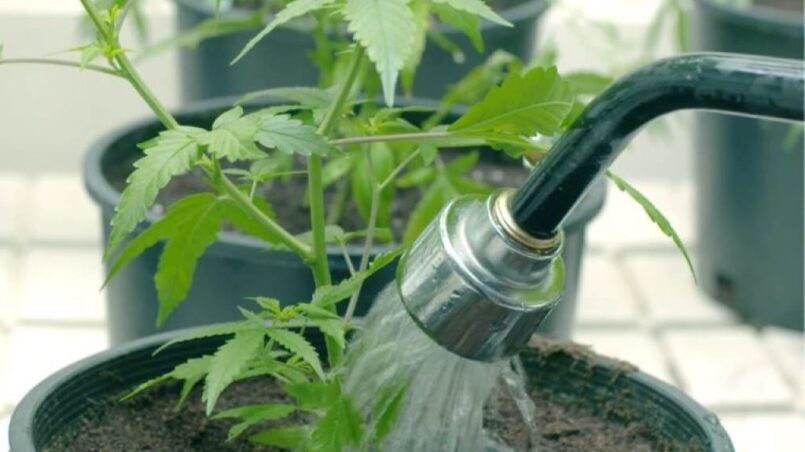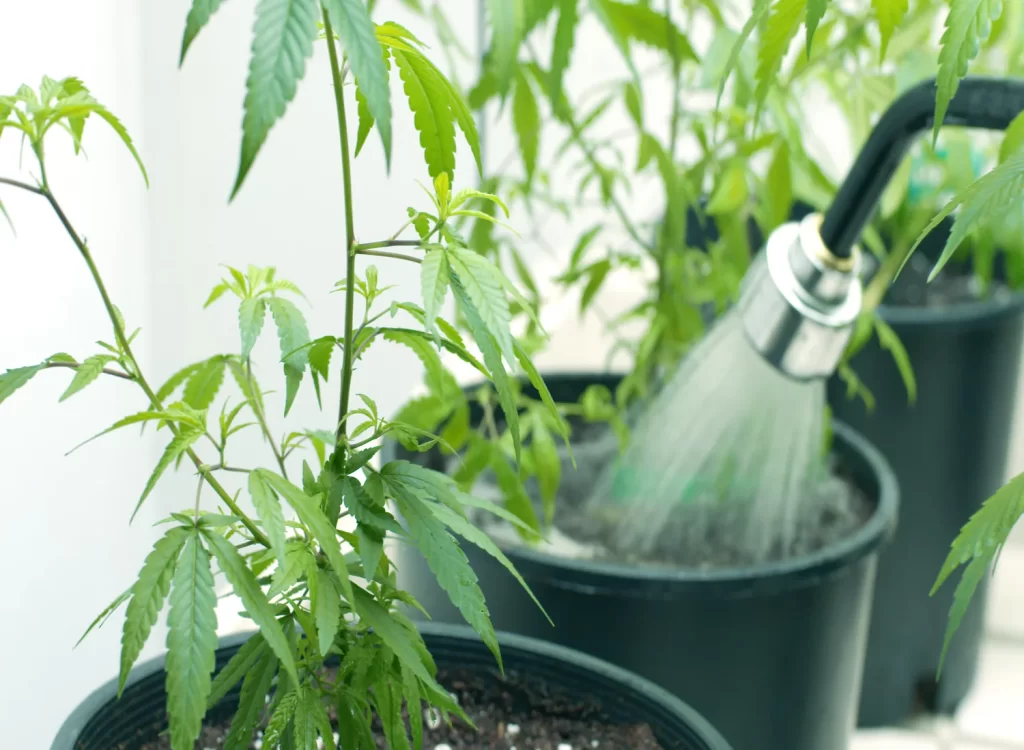Overwatering is one of the most common causes of houseplant death. It can lead to root rot, fungus gnats, mold, and more. Flushing your plants regularly removes built-up salts, minerals, and chemicals from the soil to prevent these issues. However, washing plants properly is essential to avoid shock or further overwatering. Follow this guide to thoroughly how to flush plants without overwatering.
Why Flushing Plants is Important
Flushing serves several vital purposes for houseplants:
Removes Excess Fertilizer and Mineral Buildup
When you fertilize plants, the roots do not fully absorb all the nutrients. The excess fertilizer salts can build up over time. These salts and minerals like calcium, magnesium, and chlorine can reach toxic levels for plants. Flushing helps wash away any surplus fertilizer to prevent fertilizer burn.
Clears Out Accumulated Salts
Tap water and even filtered water contain dissolved salts. Each time you water, these salts remain behind and can accumulate in the soil. Flushing periodically leaches out the built-up salts.
Provides Fresh Water and Oxygen to Roots
Stagnant water in the soil can prevent oxygen from reaching the roots. Flushing the soil with fresh water helps improve drainage and increases oxygen levels around the roots. Proper oxygenation promotes healthy root growth.
Controls pH Fluctuations
Soil pH often rises over time from salts and fertilizers. Flushing can help stabilize pH at appropriate levels for optimal plant nutrient availability.
Deters Fungal Gnats
Fungus gnats are attracted to moist, soggy soil. Flushing reduces excess moisture to discourage these annoying pests from laying eggs in the soil.
Prevents Root Rot
Excess moisture promotes fungal and bacterial growth like root rot. Flushing removes surplus water and improves drainage, creating a less hospitable environment for rot pathogens.
Flushing your plants every few weeks provides these essential benefits to maintain their health. But do not over-flush your plants, which can also damage them.
How Often Should You Flush Plants?
There’s no set schedule for when to flush plants. Generally, houseplants should be washed every 2-4 weeks in the growing season and once a month in the winter when plants are dormant. However, several factors influence how often plants need flushing:
- Water Quality – Plants in hard water that are high in minerals need more frequent flushing, like every two weeks. Plants in soft, purified, or distilled water may only need flushing every 4-6 weeks.
- Fertilizer Application – Heavily fertilized plants need more flushing to prevent buildup. Lightly fertilized plants can go longer between flushes and flush 1-2 weeks after applying fertilizer.
- Potting Soil – Soilless mixes like peat and coconut coir flush easily, while soils with more loam or clay hold onto salts and require more flushing.
- Plant Type – Salt-sensitive plants like ferns and palm species need more frequent flushing than salt-tolerant plants like succulents, which require less.
- Pot Size – Small pot Plants often need weekly flushing as salts build up faster than in larger pots. Larger pots can sometimes go 4-6 weeks between flushes.
- Environment – Warmer and more humid climates cause faster mineral accumulation, so plants need more flushing than plants in excellent, dry locations.
Pay attention to these factors to determine the ideal flush frequency for your houseplants. Their appearance and growth rate will indicate when they need flushing.
Steps to Flush Plants Without Overwatering
Flushing houseplants is easy. The key is giving the soil an extensive, deep watering until water drains freely from the bottom of the pot. Follow these steps to flush plants without overwatering:
1. Water Plants Normally First
Flush plants only after the soil is already moist. Water your plants normally and let the excess drain out. Never flush on dry soil, which can displace soil and damage roots.
2. Move Plants to a Bathtub or Sink
Flushing can be messy, with water overflowing the saucer and dripping down the sides of pots. Move your plants to a bathtub, kitchen sink, or outdoors where water can freely drain without making a mess.
3. Optional: Use Distilled or Purified Water
Use distilled or purified water rather than tap water for a more thorough flush. PPure water will rinse away more salts than tap water containing minerals. Or alternate tap and purified water.
4. Water Plants Thoroughly and Slowly
Use a watering can or hose attachment and apply water slowly to the soil surface. Water slowly enough to thoroughly saturate the soil without overflowing the rim and draining out immediately.
5. Allow Soil to Drain
When the top of the soil looks wet, stop watering. Allow the excess water to drain completely from the bottom of the pot. You should see water coming from the drainage holes.
6. Repeat Watering and Draining
Water the plant again, allowing the soil to drain between waterings fully. Repeat this cycle 2-3 times until the soil is thoroughly flushed. The number of cycles depends on pot size.
7. Inspect Drainage Water
The drainage water should run clear by the last flush. Do another flush cycle to remove more tannins and salts if it’s still brown or yellow.
8. Allow Pots to Drain Completely
After the final flush, drain the pots thoroughly without standing water in the saucer. This may take a couple of hours.
9. Return Plants to Normal Location
Once the dripping stops, you can return your plants to their regular spots. There is no need to re-water right away after flushing.
Be sure to flush all your plants, not just visibly struggling ones. Flushing is beneficial for all plants and helps prevent issues down the road.
Read Also: WHITE EGGPLANT WHEN TO HARVEST? INSIDER TIPS FOR OPTIMAL PICKING
Signs Your Plants Need Flushing
While you should regularly flush plants as a maintenance practice, your plants will also display signs when they are overdue. Pay attention to these cues:
- Slow or stunted growth
- Yellow or browning leaf tips
- Leaf curl
- Wilty, drooping leaves
- Leaf drop
- White crusty mineral deposits on soil
- Fungus gnats
These symptoms indicate it’s time to give your plants a good flush. Flushing can restore nutrient balance and reverse damage if caught early.
What Not to Do When Flushing Plants
Some common flushing mistakes can accidentally harm or overwater your plants. Avoid these errors:
- Don’t flush bone-dry soil – Pre-moisten first.
- Don’t use cold water – Use water at room temperature.
- Don’t flush repotted plants. Wait 1-2 weeks until they are settled.
- Don’t leave plants sitting in water – Drain thoroughly after.
- Don’t flush with pure distilled every time – Alternate with a tap.
- Don’t flush during dormancy or flowering – Stick to regular watering.
- Don’t flush too frequently – Consider plant needs and soil type.
Be cautious when flushing delicate plants like African violets and orchids, which don’t tolerate overwatering well. Ensure they drain properly and the soil dries adequately before the next watering.
Alternative Options for Flushing Plants
If collecting and flushing all your plants in the shower sounds like a hassle, you have some other options for flushing:
- Use the tub or sink for only your largest plants, and flush smaller plants in their pots over a bucket.
- Install a plant hose sprayer in your sink, or take plants outdoors for flushing.
- Place pots on a plant drip tray and flush individually, emptying the tray after each plant.
- Allow rainwater to soak and flush outdoor container plants thoroughly.
- Rinse the entire bare root ball if repotting, removing old soil before placing it in new soil.
Find a flushing method that works for your space and collection. Just be sure to flush thoroughly and not too frequently.
Troubleshooting Overwatering After Flushing
If you notice your plants declining, wilting, or dying after flushing, you may have overwatered them through incorrect or excessive flushing. Here’s how to troubleshoot:
- Check that the soil is drying out adequately before watering again. Feel with your finger to gauge moisture levels in the pot.
- Use your finger to poke holes to aerate the soil and encourage drying.
- Move the plant to a warmer spot with good air circulation to help the soil dry faster.
- Repot in fresh, well-draining soil if the original soil stays soggy. Discard any rotted roots.
- Water minimally to keep the roots moist until the soil dries out.
- Remove any standing water in the saucer after watering and flushing.
- Consider using a moisture meter to identify when to resume regular watering.
With some adjustments after flushing, you can get your plants back on track if you overdid the watering a bit. The soil should dry adequately within 5-7 days after flushing.
FAQs
How is flushing different than regular watering?
Flushing uses more water to saturate and leach the entire soil profile. Regular watering only moistens the top few inches.
Can I use fluoridated tap water to flush?
Yes, fluoridated tap water is fine for flushing. The small amount of fluoride is not harmful.
Should I fertilize after flushing?
Wait 1-2 weeks after flushing to resume fertilizer. The flush removes built-up fertilizer salts.
How long does the soil take to dry after flushing?
Soil should dry within 5-7 days after flushing. Take care not to water again until the soil approaches dryness.
Can I flush orchids?
Yes, phalaenopsis and dendrobium orchids can be flushed just like other houseplants. Avoid overwatering, which they are sensitive to.
Conclusion
Flushing houseplants regularly is a simple practice that provides significant benefits. Washing every few weeks can prevent fertilizer buildup, salt accumulation, and other issues like fungus gnats and root rot. Follow the steps above to thoroughly rinse the soil without going overboard. Please pay attention to your plants for signs they need a flush. Your plants will thrive in clean, fresh soil with the proper flushing schedule and method.














